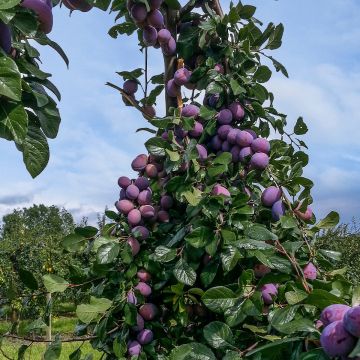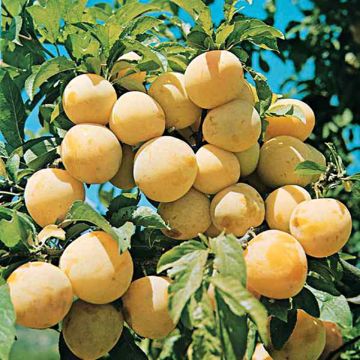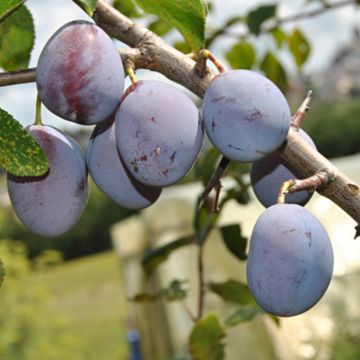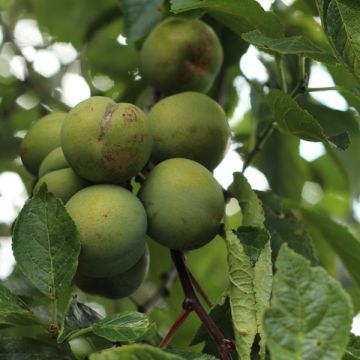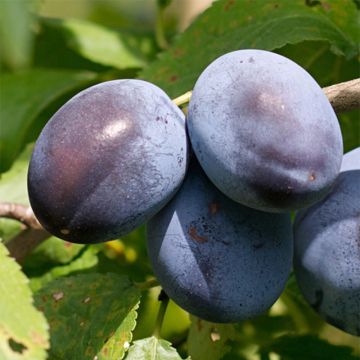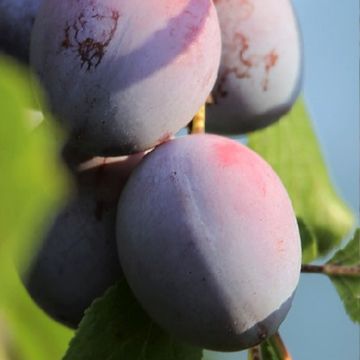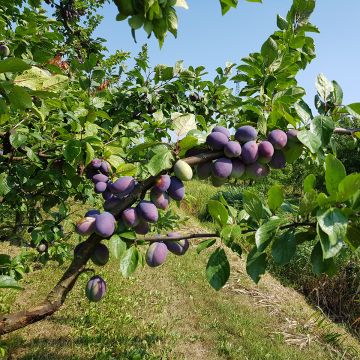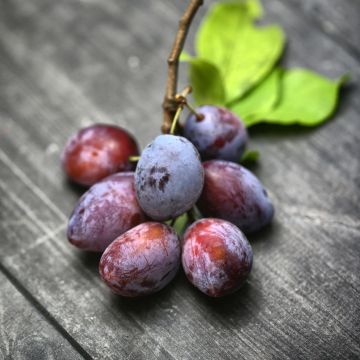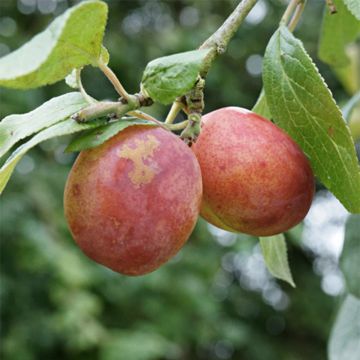

Prunier Reine Claude d'Oullins Bio en racines nues, forme scion
Prunus domestica Reine Claude d'Oullins - Organic Common plum
Prunus domestica Reine Claude d'Oullins
European plum, Common plum, Garden plum
Why not try an alternative variety in stock?
View all →This plant carries a 6 months recovery warranty
More information
We guarantee the quality of our plants for a full growing cycle, and will replace at our expense any plant that fails to recover under normal climatic and planting conditions.
Oversize package: home delivery by special carrier from €6.90 per order..
Express home delivery from €8.90.
Delivery to Corse prohibited: UE law prohibits the import of this plant from mainland France to Corse as part of the fight against Xylella fastidiosa. Please accept our sincere apologies.
More information

Description
The 'Reine Claude d'Oullins' Organic Greengage is a vigorous, productive, and hardy variety. Self-fertile, it is also an excellent pollinator for other 'Reine-Claude' varieties. Its fruits ripen from late July to August, offering a spread-out harvest. They are round, measuring 4 to 4.5cm (2in) in diameter, and have a thin skin, yellow canary in colour tinged with pink at ripeness. The flesh is green-yellow, semi-fine, semi-tender, sweet, and fragrant. These fruits are mainly used for preserves and jams. This plum tree is naturally resistant to moniliasis, and its fruits do not fall prematurely, making it valuable for windy areas.
Plant from Organic Agriculture.
The origin of plum trees is believed to be Syria, not China. During the time of Roman hegemony in the region, various local fruits including the plum were introduced to Rome. The 'Reine Claude Dorée' or Greengage has been known since then. The 'Reine-Claude d'Oullins' Gage is a variety native to the Lyon region. It was discovered, or perhaps only distributed, by Monsieur Massot in Oullins in the 19th century.
This fruit tree naturally grows up to 8m (26ft) tall at maturity. Its free and slender silhouette is appreciated. It requires little care and maintenance thanks to its hardiness and disease resistance. It thrives in full sun or partial shade and can grow in any type of rich, moist, deep, and even heavy soil, but without limestone.
Its leaves are oval, almost oblong, crenate-dentate, and slightly pubescent. Flowering occurs in mid-March for this variety, and it withstands light frosts well. The tree becomes completely covered with white flowers that appear on the previous year's branches. They are self-fertile. This plum tree is particularly good for pollination. It can be used for all varieties of 'Reine Claude dorées'. The fruits, 'Reine-Claudes', are spherical, 4 to 4.5cm (2in) in diameter, with a thin skin, yellow canary in colour tinged with pink at ripeness. They have a short shelf life and are quite sensitive to handling. The flesh, green-yellow in colour, is semi-fine, semi-tender, sweet, and fragrant. These fruits are mainly used for preserves and jams.
Plums are consumed raw at the base of the tree, in fruit salads, but also in desserts, pastries, and as accompaniments to meats and dishes. They are transformed into jams, of course, but also into canned fruits, compotes... They can also be used to make brandy.
Designed for organic cultivation, growing 'Reine-Claude d'Oullins' Organic Gage will be more successful under certain conditions. To prevent diseases and pests, you will need to:
- choose a deep, light, rich, and well-draining soil,
- avoid planting in an area that has hosted other woody plants,
- prune to promote tree ventilation,
- thin out to prevent the development of diseases on the fruits,
- apply compost in limited quantities in autumn, depending on the richness of your soil, and plant grass around the base,
- install multi-species hedges (except Prunus), piles of stones and wood, and nest boxes (for birds, voles, and bats) to attract beneficial insects.
In case of disease, it will be necessary to remove and burn the affected parts. The 'Reine-Claude d'Oullins' Organic Gage is resistant to moniliasis. Bordeaux mixture treatments should only be used in case of prolonged humidity and problems.
For transport reasons, our tallest scions may be pruned before shipment. They are suitable for all common training sizes: cordons, espaliers, goblets, half-standards, and low standards, except for high standards. If you would like more information or advice on training your fruit trees, please do not hesitate to contact us.
Report an error about the product description
Prunus domestica Reine Claude d'Oullins - Organic Common plum in pictures


Plant habit
Fruit
Flowering
Foliage
Botanical data
Prunus
domestica
Reine Claude d'Oullins
Rosaceae
European plum, Common plum, Garden plum
Western Europe
Other Plum Trees
Planting and care
Easy to grow, the Organic 'Reine Claude d'Oullins' Gage Tree thrives in any type of light, rich, neutral or acidic soil, moist but not overly wet, and without limestone. Ensure proper drainage of the planting hole by adding a thin layer of gravel. Dig a hole two to three weeks before planting, twice as wide and deep as the pot. On the day of planting, place the tree with its pot in a basin of water, allowing the entire root ball to be moistened through capillary action. Add compost to the bottom of the hole. Place the tree in the hole and fill with a mixture of soil and compost. Do not bury the graft union. Firmly tamp down the soil at the base. The root ball should be completely covered. Water thoroughly.
You can add a small handful of wood ash, rich in potash, during winter to enhance fruit production.
Planting period
Intended location
Care
-
, onOrder confirmed
Reply from on Promesse de fleurs
Haven't found what you were looking for?
Hardiness is the lowest winter temperature a plant can endure without suffering serious damage or even dying. However, hardiness is affected by location (a sheltered area, such as a patio), protection (winter cover) and soil type (hardiness is improved by well-drained soil).

Photo Sharing Terms & Conditions
In order to encourage gardeners to interact and share their experiences, Promesse de fleurs offers various media enabling content to be uploaded onto its Site - in particular via the ‘Photo sharing’ module.
The User agrees to refrain from:
- Posting any content that is illegal, prejudicial, insulting, racist, inciteful to hatred, revisionist, contrary to public decency, that infringes on privacy or on the privacy rights of third parties, in particular the publicity rights of persons and goods, intellectual property rights, or the right to privacy.
- Submitting content on behalf of a third party;
- Impersonate the identity of a third party and/or publish any personal information about a third party;
In general, the User undertakes to refrain from any unethical behaviour.
All Content (in particular text, comments, files, images, photos, videos, creative works, etc.), which may be subject to property or intellectual property rights, image or other private rights, shall remain the property of the User, subject to the limited rights granted by the terms of the licence granted by Promesse de fleurs as stated below. Users are at liberty to publish or not to publish such Content on the Site, notably via the ‘Photo Sharing’ facility, and accept that this Content shall be made public and freely accessible, notably on the Internet.
Users further acknowledge, undertake to have ,and guarantee that they hold all necessary rights and permissions to publish such material on the Site, in particular with regard to the legislation in force pertaining to any privacy, property, intellectual property, image, or contractual rights, or rights of any other nature. By publishing such Content on the Site, Users acknowledge accepting full liability as publishers of the Content within the meaning of the law, and grant Promesse de fleurs, free of charge, an inclusive, worldwide licence for the said Content for the entire duration of its publication, including all reproduction, representation, up/downloading, displaying, performing, transmission, and storage rights.
Users also grant permission for their name to be linked to the Content and accept that this link may not always be made available.
By engaging in posting material, Users consent to their Content becoming automatically accessible on the Internet, in particular on other sites and/or blogs and/or web pages of the Promesse de fleurs site, including in particular social pages and the Promesse de fleurs catalogue.
Users may secure the removal of entrusted content free of charge by issuing a simple request via our contact form.
The flowering period indicated on our website applies to countries and regions located in USDA zone 8 (France, the United Kingdom, Ireland, the Netherlands, etc.)
It will vary according to where you live:
- In zones 9 to 10 (Italy, Spain, Greece, etc.), flowering will occur about 2 to 4 weeks earlier.
- In zones 6 to 7 (Germany, Poland, Slovenia, and lower mountainous regions), flowering will be delayed by 2 to 3 weeks.
- In zone 5 (Central Europe, Scandinavia), blooming will be delayed by 3 to 5 weeks.
In temperate climates, pruning of spring-flowering shrubs (forsythia, spireas, etc.) should be done just after flowering.
Pruning of summer-flowering shrubs (Indian Lilac, Perovskia, etc.) can be done in winter or spring.
In cold regions as well as with frost-sensitive plants, avoid pruning too early when severe frosts may still occur.
The planting period indicated on our website applies to countries and regions located in USDA zone 8 (France, United Kingdom, Ireland, Netherlands).
It will vary according to where you live:
- In Mediterranean zones (Marseille, Madrid, Milan, etc.), autumn and winter are the best planting periods.
- In continental zones (Strasbourg, Munich, Vienna, etc.), delay planting by 2 to 3 weeks in spring and bring it forward by 2 to 4 weeks in autumn.
- In mountainous regions (the Alps, Pyrenees, Carpathians, etc.), it is best to plant in late spring (May-June) or late summer (August-September).
The harvesting period indicated on our website applies to countries and regions in USDA zone 8 (France, England, Ireland, the Netherlands).
In colder areas (Scandinavia, Poland, Austria...) fruit and vegetable harvests are likely to be delayed by 3-4 weeks.
In warmer areas (Italy, Spain, Greece, etc.), harvesting will probably take place earlier, depending on weather conditions.
The sowing periods indicated on our website apply to countries and regions within USDA Zone 8 (France, UK, Ireland, Netherlands).
In colder areas (Scandinavia, Poland, Austria...), delay any outdoor sowing by 3-4 weeks, or sow under glass.
In warmer climes (Italy, Spain, Greece, etc.), bring outdoor sowing forward by a few weeks.


































